![]()
![]()
![]()
Use LEFT and RIGHT arrow keys to navigate between flashcards;
Use UP and DOWN arrow keys to flip the card;
H to show hint;
A reads text to speech;
40 Cards in this Set
- Front
- Back
- 3rd side (hint)

|
Jackson Pollock, Mural, NY School
|
Still working with canvas on the wall, not on the floor yet. Commissioned to make a piece for Peggy Guggenheim's foyer in her apartment (long, awkward space) Commission in November, had a 2 month block about what to do
• Almost too much pressure with such a huge space • New Year’s Day 1944 executed the entire thing (supposedly) Painted on canvas and attached to the wall Painted straight from the tube mostly FORM • Vertical elements (black paint) • Free-floating color around these o Like Benton’s mural theory • Rhythmic • Movement from right to left (opposite of how we read) o Would start with pirouette of paint from the edge and then move off with vertical or horizontal movements Now at the University of Iowa • “it was a stampede… [of] every animal in the American West, cows and horses and antelopes and buffaloes. Everything is charging across that GD surface.” • Much more abstract than previous works, but you can still see symbolism A breakthrough work for Pollock as Guggenheim gave his first solo show |
|
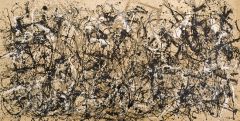
|
Jackson Pollock, Autumn Rhythm (No. 30), NY School
|
o Allowed Hans Namuth, a German photographer, into the barn he had made into his studio (hardly allowed Krasner)
o Cannot totally control where the paint lands or what happens when it does • Controls movement of body • Force of the flinging • The directionality of the paint “NO chaos, GD it” • No focus of the work, the eye may wander wherever exemplifies the extraordinary balance between accident and control that Pollock maintained over his technique. The words "poured" and "dripped," commonly used to describe his unorthodox creative process, which involved painting on unstretched canvas laid flat on the floor, hardly suggest the diversity of the artist's movements (flicking, splattering, and dribbling) or the lyrical, often spritual, compositions they produced. Although Pollock's imagery is nonrepresentational, "Autumn Rhythm" is evocative of nature, not only in its title but also in its coloring, horizontal orientation, and sense of ground and space |
|
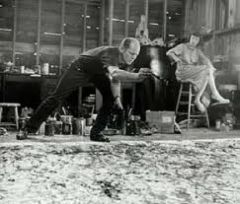
|
Hans Namuth, Photo of Jackson Pollock Painting, NY School
|
o Allowed Hans Namuth, a German photographer, into the barn he had made into his studio (hardly allowed Krasner)
• Hans Namuth films Pollock painting a work outside, then films from under a piece of glass to show a breakthrough view of Pollock’s technique • Pollock reads from a sort of manifesto that he wrote about the meaning and process of his work • After these experiences, spirals into alcoholism again intrusion of his private processes? |
|
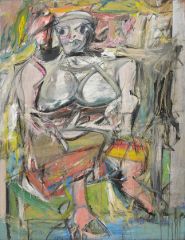
|
Willem De Kooning, Woman I, NY School
|
o Gestural - the hand of the artist is apparent everywhere
o Breasts sort of recede back into the body, not a realistic representation o The background pushes forward, the figures recede back into space o What do we see first? The face • The most realistic or naturalistic element is what we jump to • The mouth is grotesque, the eyes are large, the nose is flat, the face is unsymmetrical o “Sometimes women really irritate me” • Is it misogynistic? o Pin-up girls in his studio • Abstraction of pin-up girls? o Reference back to ancient sculpture – Cycladic Woman as a sex symbol and fertility goddess "the female painted through all the ages, all those idols" derived partly from the feminine within him not misogynist, but humorous |
|
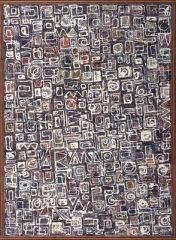
|
Lee Krasner, Composition, NY School
|
Was trained by Hoffman, learned the "rudiments of Cubism" and sympathized with Surrealism, but eventually gave it up with Pollock's influence. Tight, geometric composition (tidying up her husband's style? sweeping lines --> tidy geo forms) dull color palette, almost like Pollock's Lavendar Mist. GESTURAL. Oil on canvas. Made on the floor or on a table. "Little Image" painting.
|
|
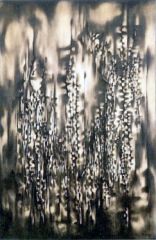
|
Norman Lewis, Every Atom Glows: Electrons in Luminous Vibration, NY School
|
• Looks like a photograph
• “crackling” effect • Atomic subject matter in works from Pollock and the like – atomic fission is a hot topic at the time, artists are showing their curiosity |
|

|
David Smith, Hudson River Landscape, NY School
|
• Had very narrow subject matter
o Took train from upstate NY into the city where his studio was o Borrowed from landscapes • Blue collar background o Was a mechanic o Association of his materials with his background made him “different” • Painting was “high art” • Industrial process o Would sometimes weld tools into the sculptures that he made • Intuitive process o Action to how he put things together o Worked quickly o Flat, mimicked the picture plane |
|
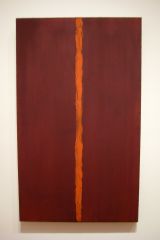
|
Barnett Newman, Onement I, Color Field Painting
|
o Basic field of color, a “zip” vertical line down the field of color
o What could it mean? • The individual in the midst of the world • Division between two sides: war? o The line isn’t perfect • Paint globs: calls attention to the paint itself, the material • Imperfection: straight, right, but not pristine o Thinking about the most basic act a person can make: making a mark in a field • We as human beings make a change • Walking back and forth through a field, becomes a path, then a road, then civilization • What art IS at its most essential: making a change, doing something to something else |
|
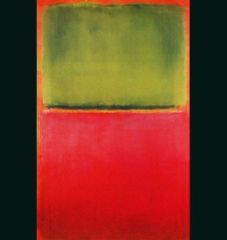
|
Mark Rothko, Green, Red on Orange, Colorfield Painting
|
o Basic human image: a landscape
• Division of the sky from the earth • Compare Lavender and Mulberry to Caspar David Friedrich’s Monk by the Sea How small we feel in the face of the enormity of the universe |
|
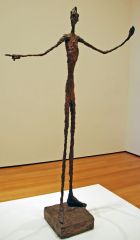
|
Giacometti, Man Pointing, Postwar European Art
|
Bronze
o Lonely, lots of space o Different from monumental sculpture • Anonymity • No mass, no presence • Alienation • Knew the cubists and surrealists o In the 30’s got sick of surrealism and the academic tradition • Wanted to work from memory rather than dreams or looking at something and re-presenting it |
|
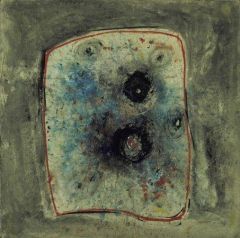
|
Wols, Painting, Postwar European Art
|
o Influenced by surrealists in Paris
o Spent some time in Spain • Ends in 1939 – interred as an enemy alien (POW) for a year • Meets Jean Paul Sartre o Through him, met owner of a gallery • Provided him with larger canvases after first show (~40 paintings) • Catalyst into his mature style • 1945 – first show Showing tiny, postcard sized paintings • Declined after these gallery shows o Self destruction o Hotel to hotel o Died of food poisoning • Used rotten food and dead animals in his work |
|
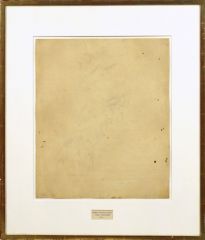
|
Rauschenberg, Erased De Kooning, Neo-Dada
|
o Asked De Kooning to draw something so he could erase it
• He drew it with a very greasy pencil so it would be hard to erase o Why? • To show that there are cycles of generations, one canceling out the next and so on • Maybe show that though art changes, you can never truly erase what has been made • From Dada standpoint – very anti-art • Both artists’ work is presented • Thinking about VALUE: just because De Kooning is associated with it, someone would probably buy this • Speculation: De Kooning was very “macho” while Rauschenberg was seen as “weaker” (he was a bisexual) so maybe it was a challenge |
|
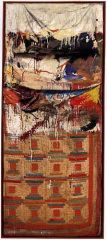
|
Rauschenberg, Bed, Neo-Dada
|
• Made from paint, a quilt, and a pillow
• Hangs on the wall, not on the floor like a bed would be • Early influences Drip painting • Bodily effect – fluid or liquid in a bed EW • Would make sense in an action painting Colorfield painting • Horizontal registers oriented vertically Long, vertical orientation of the canvas • Chinese paintings? American folk art and abstraction in the quilt • Looks sort of like Albers painting • Rauschenberg was taught by him at BMC and grew to reject his ideas • Why? Homogeneity between art forms • Not “this means this” but an open field for discussion |
|
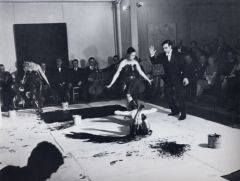
|
Yves Klein, Anthropometries of the Blue Period (Paris), New Realism
|
• Like Rauschenberg’s blueprints?
• Made with the female body, he doesn’t touch them or the canvas He did not position the women, he directed them Had them press themselves with paint, then either press their bodies on the canvas or drag themselves across the floor • Wore a blue tuxedo Master of ceremonies? • Had an orchestra play Symphony called the “monotone symphony” 20 minutes of one tune, 20 minutes of silence |
|
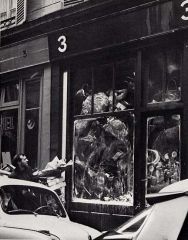
|
Arman, Le Plein (Galerie Iris Clert, Paris), New Realism
|
• Countered by Arman, Le Plein (Fullness), 1960
Took all of the art out of the same gallery and filled the gallery with trash COUNTERED: THE VOID • Created a void by removing everything from the gallery It was empty, but “impregnated with spirit” The gallery walls were white-washed Had a party • 3,000 were invited • Outside were members of the Republican Guard • Some people found it funny • Some found it profound (stereotypical) • Some were moved o Albert Camus – “With the void, full powers” in the guestbook • Blue cocktails o People peed blue (they were dyed) |
|
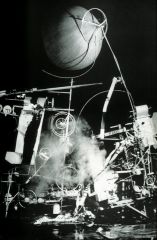
|
Tinguley, Homage to New York (MoMA), New Realism
|
o Three weeks working with four assistants
o A machine that consumes itself • Makes itself to destroy itself o Set it up in the courtyard of the MoMA in NY o Audience were high-brow museum goers o Was supposed to be set in motion, run for 30 minutes and then explode • Took an hour and a half • Sputtered, smoked • Parts flew off toward the audience • LOVED all of this – this was chance, letting go of control and predictability o Disney wanted to make a film of it • Instead, audience scavenged parts that flew off and it no longer exists |
|
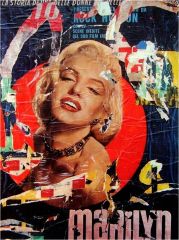
|
Rotella, Untitled Decollage, New Realism
|
o Would go around large cities and follow vandals
o Watch what they were doing and became interested in what they were paying attention to o Would find where posters were pasted up • Would start to remove the sections of pasted posters • Then remove different layers of the old posters Archaeology? Peeling back layers of the city to see what is really underneath |
|
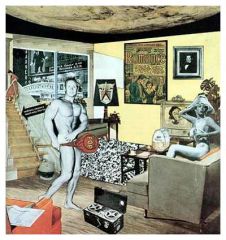
|
Richard Hamilton, Just what is it that makes today's homes so different, so appealing?, British Pop
|
o Cover of catalogue
o Became the face of British pop culture o What is “pop”? • Popular, transient, expendable, low cost, mass produced, young, witty, sexy, gimmicky, glamorous, big business o Initial reactions • Called pop and it has “pop” in it (tootsie pop in specific location) • Materials: newspaper clippings, ads, science magazines, movie theater, signage, high art (portrait), TV and mass communication, two naked people in different forms, the floor is an image that’s been blown up beyond recognition |
|
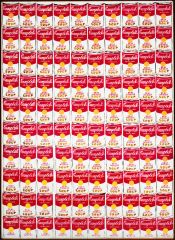
|
Warhol, 100 Cans, American Pop
|
Becomes his “thing”
Takes can • A readymade, VERY influenced by Duchamp Overwhelming feeling of mass culture and commodity Begins with acrylic on canvas • After this works almost exclusively with silk-screening |
|
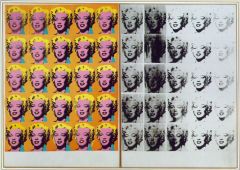
|
Warhol, Marilyn Diptych, American Pop
|
• She was a media-image or a persona (tragic)
• Bought a headshot, cropped it, silk screened paint onto it, duplicated it for the entire series Is she a modern-day saint? Altarpiece • Garish, bright color and black and white • Alive vs. dead? • Marilyn vs. Norma Jean? • What is the original, or what is the most accurate of all of the images? |
|
|
Figurative abstraction
|
o Figurative Abstraction
• Essentially abstract, but some hint of true form of the figures o This is a poetic expression of the essence of the myth • Impact of elemental truth • “Would you have us convey this abstract concept by means of a boy and a girl tripping lightly” Should we create a work that conveys the abstract nature of the myth, the complexities, or show them running innocently through a field? UNIVERSAL TRUTHS, essences, concepts, but NOT by illustration. By EMBODIMENT of the concept examples: Gottlieb, Rothko, even more recently in Richter |
|
|
|
Automatism
|
o Let your arm go wherever it will, don’t think things through, FREE EXPRESSION (like stream of consciousness in writing)
• Explore the unconscious mind, primitive, most essential It’s universal – everyone has this experience Very personal – what is in MY mind • Latent thoughts and desires Not suppressed by the rational mind – rationalized and controlled by society These are the bad things that led to WWI/II Get BACK to essential human-ness • Ultimate goal: FIX the individual, engender REFORM in society First thing you have to have is revolution of the mind ex: Andre Masson |
|
|
|
Existentialism
|
o Action as a means of knowing oneself
o Heroic struggle against life • “in a word, man must create his own essence… it is in throwing himself into the world, in suffering it, in struggling with it, that little by little he defines himself.” – Sartre Examples: o Pollock, Self-Portrait, 1930s • Angst, fear, tension • Heroicism is an important metaphor surrounding these artists • Navajo Sand Painting |
|
|
|
the “zip”
|
A vertical "interruption" in a unified color field. coined by Newman. Was part of the established basic formula. The means for the philosophy behind his paintings. It created a sort of divide:
o What could it mean? • The individual in the midst of the world • Division between two sides: war? o The line isn’t perfect • Paint globs: calls attention to the paint itself, the material • Imperfection: straight, right, but not pristine o Thinking about the most basic act a person can make: making a mark in a field • We as human beings make a change • Walking back and forth through a field, becomes a path, then a road, then civilization • What art IS at its most essential: making a change, doing something to something else |
|
|
|
Lee Krasner
|
o Taught by Hans Hoffman
• “push and pull” – painting needs to be on a flat surface but needs to have tension • Hoffman, Table with Teakettle, Green Vase, Red Flowers, 1936 Tensions between structure and spontaneity Between abstraction and expression o Met Pollock around 1943 • Already a mature artist He’s depressed He learned from people around him, even though he is known as a breakthrough artist o Married in 1945 and move out to the Hamptons • Gives up her career for the most part Works in a different kind of way Works get smaller and tighter, more and more structured o Artists: Man and Wife review in ArtNews • “There is a tendency among some of these wives to ‘tidy up’ their husbands’ styles. Lee Krasner takes her husband’s paints and enamels and changes his unrestrained, sweeping lines into neat little squares and triangles” o After Pollock’s death Bigger, vibrant colors, exploding shapes and lines, organic palette Living example of tension: struggling between genres and finding her form of expression, finding an image |
|
|
|
Norman Lewis
|
• From Bermuda
o Studied art and art history very early o Spent time in Europe before coming to America • Moved to Harlem o Studied with Augustus Savage (Harlem Renaissance) o Went to Columbia University o Taught throughout his career o Knew Alain Locke • Encouraged African American artists to look at their history and then re-imagine it for their art purposes • But Lewis didn’t want any responsibility for using solely African American forms – against Locke’s idea • Treated as an equal with a lot of other artists, but ignored by collectors and critics “not universal enough, too specific, too personal” showed tension in the art world: push and pull |
|
|
|
Art Informel
|
Art Informel – “formless” art
emphasized intuition and spontaneity Tachisme (from the French tache, or blot) is a subset of Art Informel that yielded works related to Jackson Pollock’s Abstract Expressionist poured (or “drip”) paintings. The Tachiste Georges Mathieu abandoned brushes entirely, preferring to squeeze paint directly from the tube onto the canvas. The point is not that artists renounced their concern for formal values but that they rejected the discipline and structure of geometric abstraction in favor of a less cerebral approach. |
|
|
|
Giacometti
|
• Knew the cubists and surrealists
o In the 30’s got sick of surrealism and the academic tradition • Wanted to work from memory rather than dreams or looking at something and re-presenting it o Things that are slowly disappearing o Figures are brought together by the base, but they are separated and don’t seem to respond to one another o Attempt to connecting • Brings the empty space around the figures into the object • About the “nothingness” in between o Interested in prehistoric, primitive, Greek, Egyptian, cave art o Fits into Newman’s “zip” concept o Difficult for him to decide when something was ready to be caste • Struggled with failure o A model for something that was meant to be human scale • Was supposed to be installed in a plaza in New York |
|
|
|
matter painting
|
building up on the surface of canvas (sand, paint, plaster)
Fuatrier -- raised the partially hidden and highly distorted faces of the hostages to the picture’s surface. Dubuffet - This plastic approach to painting, which released the material character of paint, resulted in an entirely new reception of art. Rather than simply being presented with a flat image, the beholder was exposed to a graspable surface, which penetrated space. |
|
|
|
Robert Rauschenberg,
|
• What is a sculpture, other than a sculpture? Philosophically questioning the nature of art
• Make art about life o Bridge the gap o No more division between just painting and sculpture, but breaking down the boundary between art and everyday life White paintings, black paintings, blue prints, combines, erased de kooning, tire print |
|
|
|
John Cage
|
• Four minutes and thirty seconds
o A performance where there is four minutes and thirty three seconds of silence, so the music is whatever is occurring around the room • Coughing, rustling in seats, creaks, etc. • One of the first artists who brought performance art to this group o Perhaps the founder of Happenings • Met Rauschenberg at Black Mountain College o Alternative school • No grades, graduate when you feel you’re ready • Gezamptkunstwerk o A complete work of art that includes many types of fine art o Temporal, visual, spatial, etc. o Involves sound, performance, in a space • Cage had an event at BMC o Rauschenberg contributed his “white paintings” to the event – put on the ceiling and walls • Film and photos were projected onto them o People sat in a square • No one had a bad view of what was going on, but each viewer could have a very different experience o Cage lectured o People stood on ladders and read poems o Someone played a piano o Someone danced through the audience while being chased by a dog o Coffee was served |
|
|
|
The Void
|
o Leap into the Void, 1960
• Interested in levitation, flying Told people he could fly • He is leaping through a window Negatives spliced together Made a one-time newspaper called Sunday to give out at a gallery 1958 at Galerie Iris Clert, Paris • Created a void by removing everything from the gallery It was empty, but “impregnated with spirit” The gallery walls were white-washed Had a party • 3,000 were invited • Outside were members of the Republican Guard • Some people found it funny • Some found it profound (stereotypical) • Some were moved o Albert Camus – “With the void, full powers” in the guestbook • Blue cocktails o People peed blue (they were dyed) • Countered by Arman, Le Plein (Fullness), 1960 Took all of the art out of the same gallery and filled the gallery with trash |
|
|
|
Galerie Iris Clert,
|
Galerie Iris Clert, Paris
• Created a void by removing everything from the gallery It was empty, but “impregnated with spirit” The gallery walls were white-washed Had a party • 3,000 were invited • Outside were members of the Republican Guard • Some people found it funny • Some found it profound (stereotypical) • Some were moved o Albert Camus – “With the void, full powers” in the guestbook • Blue cocktails o People peed blue (they were dyed) • Countered by Arman, Le Plein (Fullness), 1960 Took all of the art out of the same gallery and filled the gallery with trash |
|
|
|
decollage
|
o Would go around large cities and follow vandals
o Watch what they were doing and became interested in what they were paying attention to o Would find where posters were pasted up • Would start to remove the sections of pasted posters • Then remove different layers of the old posters Archaeology? Peeling back layers of the city to see what is really underneath |
|
|
|
This is Tomorrow
|
• In the 1940’s London is still in a bad economy after the war
o Look to America for influence The ICA put it on • Exhibition at the Whitechapel Gallery, London, 1956 • Split into 12 interdisciplinary teams (antagonistic cooperative groups) o Maybe a critic, a painter, and an architect o Wanted to see how their different perspectives could develop the theme |
|
|
|
“hot” and “cold” pop art,
|
• British pop art was hot – engaged, passionate, out of academic background, not just reflecting popular culture
• American pop art was cold – very flat images, indifferent, removed from the work, depicted commercial objects, contradicted himself (wouldn’t let us know exactly know what he believed) |
|
|
|
Andy Warhol
|
• From Pittsburgh, born in 1928 – grew up during the Depression
• Institute of Technology – college for four years o Majored in design • 1949 went to NYC o Worked in advertising for magazines, newspapers, department store windows o Worked this way from 1950-60 o Design for window at Bonwit Teller Department Store New York, mid 1950s o Very well-known and important in the design world BEFORE he was recognized as an artist • Commercial works o Sketch-like or impressionistic • Color isn’t in the lines • Informal sensibility o Reminds us of art o Ironic that he uses this high art form, or references it, in his ad campaigns • Fine art work o Dick Tracy, 1960 • More hard-edged, more machine-like • Flip-flops modes o Works as a printmaker and fine art artist, ad maker, etc. all at once for several years o Happened upon a Roy Lichtenstein exhibition • Didn’t want to touch on cartoon works since he was • Recognized branding – artists need their own “thing” o Began reproducing advertisements |
|
|
|
silkscreen printing
|
o What does it say?
• Mass production • Silkscreen printing It is what makes the print on t-shirts, etc. Use silk or another screen, push ink through it on stencils, do one color at a time MECHANICAL process o Being used in ads, industrial processes • Warhol’s hand is removed • Physical connection to the work is distanced o Is this art? • What does it mean to put everyday materials into a gallery? |
|
|
|
John and Edith Scull,
|
o “I’d rather use art to climb [socially] than anything else.”
o Collectors used to be “old money” • Rockefellers • Guggenheims o Nouveau Riche • The New Collector Used art as investments Rise as collectors had everything to do with Andy Warhol o Edith • Came from a “new money” family, pretty well off • Married Robert, illustrator and designer • Father died, left the cab company to them Robert expanded it • Started attending gallery openings, going to museums • Started collecting from emerging artists One of them was Andy Warhol Edith Scull 36 Times, 1963 • First portrait commission for $700 • Supported local galleries Moved to the upper east side • 1973 sold collection of 50 works They hadn’t paid more than a few hundred dollars to a thousand for each Sold for $2.2 million → $10 million today People were shocked, artists felt they were denied some of this profit o A different kind of art world: tied to celebrity, big money, status, music • Celebrity culture and art culture o Some British pop artists designed the Beatles’ album covers A LOT OF PEOPLE WEREN'T HAPPY WITH THEM |
|
|
|
The Factory
|
o The silver factory on east 47th street
• Had assistants • People sent designs to be fabricated • Used to be hat manufacturer’s space o Painted walls silver and blocked windows with foil o A lot of people hung out with Warhol here • Evie Sedgwick • The Velvet Underground • Fashion models • Cross-dressers • “The Warhol Superstars” • Warhol and fame o Thought of himself and the people around him as mass-produced commodities o Death and disaster series • Taking images from the newspaper and screen printed them repeatedly • The way that we see real human tragedy, the way that it is repeated or reduced to a flat image, changes the way we think about the situation The media changes our perspective – fatigue or numbness to this disaster o Marilyn Monroe • She was a media-image or a persona (tragic) • Bought a headshot, cropped it, silk screened paint onto it, duplicated it for the entire series Is she a modern-day saint? Altarpiece • Garish, bright color and black and white • Alive vs. dead? • Marilyn vs. Norma Jean? • What is the original, or what is the most accurate of all of the images? • Warhol and boredom o Comes out of his deadpan approach to things • Everything is the same, coming from the same thing over and over and over o Made about 60 films • Sleep – 6 hr film of someone sleeping Radical monotony • Empire – 8 hr film of the empire state building • End of Warhol o Shot in 1968 by a woman who wanted to be a part of his circle o Recovers, goes to the hospital in 1987 for gall bladder surgery and dies during the surgery |
|

